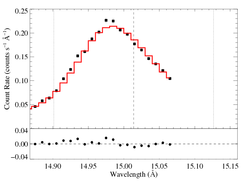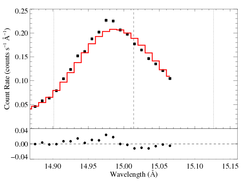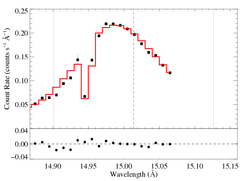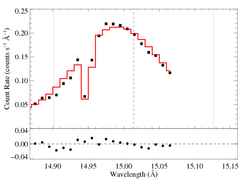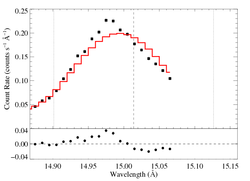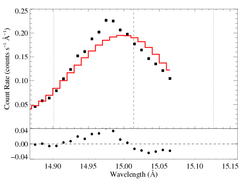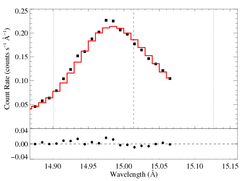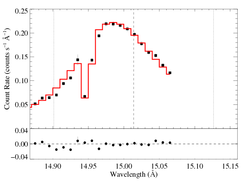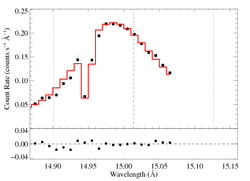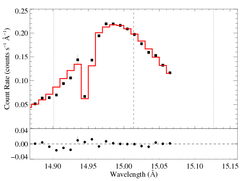ζ Pup: XMM RGS line-profile analysis
Fe XVII at 15.014 A
For this line we use both the RGS1 and RGS2 data, and as with the other lines, we do not allow shift to be a free parameter.
First we repeat the non-porous fit shown on the main page.
Non-porous: RGS1+2
We show the two spectra separately, but they were fit simultaneously. That's the same model in both plots.
Note: Because the reduced chi square of this fit is >2, XSPEC won't compute the confidence limits on the model parameters. The chi square of the best fit model is high most likely because the formal error bars are so low, while the actual errors are probably dominated by systematics (which, of course, aren't included in the error bars).
Note: The low bin on the blue wing is due to the low sensitivity of a particular detector pixel, and is thought to be well calibrated. We repeated this fit with the bin eliminated and got a very similar fit, with a very similar fit quality.
Finally, note: if you look carefully, you can see the apparent relative wavelength shift between the two datasets (the RGS1 model is shifted just a bit toward line center).
Compare the results of this fit to those derived from the same line in the Chandra spectrum. The results are quite consistent.
Next, we'll fit models with anisotropic porosity assuming flattened, radially oriented clumps. We use the "stretch" porosity length distribution, h(r), parameterized by hinf. We will fit first with hinf a free parameter, and then at fixed values of hinf = 0.5, 1, 2, and 5 R*.
aniso-porous: RGS1+2, hinf free
A best-fit hinf of 0 is found. Since we can't put formal confidence limits on our model parameters, due to the high chi-square value, this fit is identical to the one shown above.
aniso-porous: RGS1+2, hinf = 0.5
aniso-porous: RGS1+2, hinf = 1
aniso-porous: RGS1+2, hinf = 2
aniso-porous: RGS1+2, hinf = 5
We cannot compute formal confidence limits on the parameters, but it's clear that taustar shows the expected pattern of increasing gradually and then more steeply as hinf increases. And it's clear that the fit quality gets much worse with increasing porosity length and is even quite bad already at hinf = 0.5.
Now for models with isotropic porosity.
iso-porous: RGS1+2, hinf free
As with the anisotropic case, allowing the terminal porosity length to be a free parameter leads to a best-fit hinf = 0, and we recover the non-porous global best-fit model. We won't bother showing it again here.
iso-porous: RGS1+2, hinf = 0.5
Not much worse than the best non-porous fit.
iso-porous: RGS1+2, hinf = 1
Note: with hinf = 1, taustar has increased by 32 percent.
iso-porous: RGS1+2, hinf = 2
iso-porous: RGS1+2, hinf = 5
And here is an extensive log of all these xspec fits.
last modified: 10 May 2012
